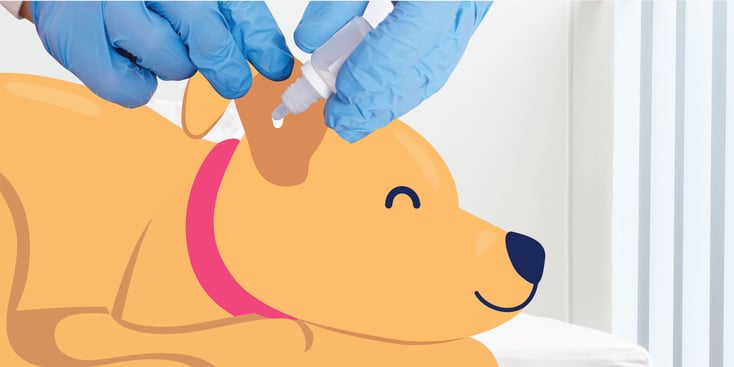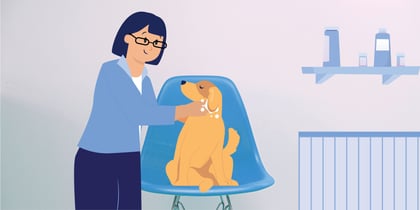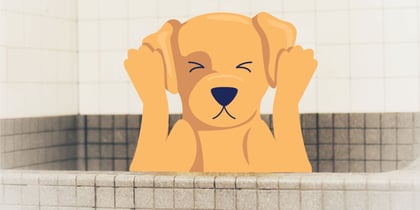Can You Put Peroxide in a Dog's Ear?

Table of Contents
While the ear canal is a self-cleaning structure, most pet parents clean their dog’s ears to remove wax build-up and prevent infections. There are many different ear cleaners used by pet parents, one of which is hydrogen peroxide.
- It’s not recommended to use hydrogen peroxide to clean your dog's ears. While it can be effective in removing dirt and debris, it can also be harmful to your dog's delicate ear canal and lead to irritation and inflammation.
- Many safe dog ear cleaners have been formulated to work specifically for dogs, and some have added medications that can help reduce the incidence of infection in the ears.
- If you notice any discharge, foul odor or your dog is frequently scratching their ears, it is best to seek veterinary advice.
Hydrogen peroxide, chemically known as H202, is a mild antiseptic solution that has been used commonly as a home remedy for cleaning wounds in people and animals since the early 1900s.
Hydrogen peroxide is a versatile compound and is also used for removing the color from hair and teeth, and in chemical cleaning compounds. Depending on the strength of the solution, hydrogen peroxide can sometimes be dangerous to pets.
Can You Use Peroxide On a Dog's Ear?
It is not recommended to clean a dog's ears with hydrogen peroxide. In fact, it is advised not to use cotton swabs, alcohol, or hydrogen peroxide to clean your dog's ears. These substances can damage the ear canal and lead to infection.
Instead, use a veterinarian-recommended ear cleaner and gently wipe the outer ear with a soft cloth. If you notice any discharge, or foul odor or your dog is frequently scratching their ears, it is best to seek veterinary advice.
How Does Hydrogen Peroxide Work?
Hydrogen peroxide fizzes on contact with skin cells, blood, and bacteria. Skin cells contain an enzyme called catalase that converts hydrogen peroxide into water and oxygen. During the reaction process, the hydrogen peroxide kills bacteria and helps remove debris.
Unfortunately, hydrogen peroxide is not specific in its target and so will also kill healthy skin cells at the same time. When healthy ear skin cells are damaged, it can lead to inflammation and increase the risk of infection in the ear. This is why veterinarians do not recommend the use of hydrogen peroxide in your dog’s ears as there is a greater risk of harm than benefit.
The fizzing sensation of the hydrogen peroxide can be stressful to dogs, who are not expecting a loud buzzing noise in their ear. Also, when the fizzing reaction is complete, the remaining compound is water. And water is a perfect environment for bacterial growth, which can lead to ear infections in your dogs.
What Is the Best Dog Ear Cleaning Solution?
Many safe dog ear cleaners have been scientifically formulated to work in dogs. Some ear cleaning solutions have added medications such as anti-inflammatory medication that can help reduce the incidence of infection in the ears. If you are unsure about what ear product to use, book a virtual vet visit for advice on the right product for you.
Home remedies to cure a dog's ear infection such as olive oil, castor oil, essential oil, and apple cider vinegar are not recommended either.
How to Clean a Dog’s Ears
Cleaning a dog’s ears is an essential part of their grooming routine. Ear cleaning should be done once weekly unless directed otherwise by your veterinarian. If you clean your dog’s ears more than once a week, you risk causing inflammation and irritation of the ears, which can lead to infections. Some dogs don’t enjoy having their ears cleaned, but with a little patience and practice, you can teach your dog to accept ear cleaning. The earlier in their life you start this process, such as when they are a puppy, the easier it will be.
1. Get Your Dog Used to You Touching His Ears
First, let your dog accept you touching his ears and lifting the outer ear to look inside. If they won’t let you do this, try distraction techniques such as touching the ears when they eat dinner or using frozen peanut butter or banana mashed onto a licki mat or puzzle feeder. Over time your dog will get used to having his ears touched and then you can move onto the cleaning stage.
2. Use a Dog Ear Cleaner
Dogs’ ears are a little different from human ears. The ear canal is an L shape, whereas a human ear canal is straight. An L-shaped ear canal makes it harder to clean out wax and debris.
Start by using a dog ear cleaner and add a few drops with the nozzle into the ear canal. It’s ok to place the nozzle into the ear canal itself to do this. Then gently massage around the base of the ear to help the ear cleaner break down the wax in the ear.
3. Remove Wax and Fluid Using a Cotton Ball
Use cotton balls at the entrance of the ear canal to remove any wax and fluid that comes out after massaging. You may find your dog will shake their ears vigorously after you apply ear cleaner so you may not get much wax out. Fear not, your dog has done the job for you! Use cotton to dry the external ear canal once you have removed the ear wax.
4. Never Use Sharp or Long Items
When cleaning a dog’s ear, it is critical to never place sharp or long items such as cotton swabs into the ears to help remove the wax. This is because if you push the swab too far into the canal, or your dog suddenly jumps from pain, you risk damaging the eardrum. Once the eardrum is damaged it is often not reversible, and your dog may have lifelong deafness in that ear because of the trauma. Use cotton balls alone or pet ear wipes when cleaning the ear.
When Should I Not Clean My Dog’s Ears?
Sometimes your pet may be suffering from an ear infection, which is different from a wax build-up. Ear infections are an accumulation of pus in the ear and they can make the ear very sensitive and painful. If you try to clean your dog’s ears and they cry out in pain or move away, you should stop straight away and schedule a veterinary check-up.
Other signs of an ear infection include:
- Yellow, green, gray, or black discharge from the ear
- A foul smell coming from the ears
- Holding the ear to one side
- Scratching at the ears
- Headshaking
- Scabs, bleeding
If you see any of these signs a check-up with a veterinarian is needed. The vet will look at your pet’s ears and skin and take a sample of the ear discharge to find the source of the infection. Medication will be given to treat the ear infection. Your veterinarian may also tell you to clean the ears before applying the ear drops. Ear infections are usually cured quickly once the medication is started.
Frequently Asked Questions
How do I know if my dog's ear is bacterial or yeast infection?
Dark brown or black earwax in dogs is often linked to yeast and/or bacterial ear infections. These infections can be caused by a variety of factors, including allergies, moisture, and foreign bodies in the ear.
Can you use hydrogen peroxide to treat a dog ear yeast infection?
To treat a dog ear yeast infection, avoid using alcohol or hydrogen peroxide. These solutions can cause irritation and potentially worsen the infection. Instead, a veterinarian can recommend anti-fungal medication, ear drops, or a specialized cleaning solution.
How do you get rid of a yeast or bacterial infection in a dog's ear?
If your dog has a yeast or bacterial infection in their ear, it's important to see a vet for proper diagnosis and treatment. The vet might prescribe a topical antifungal ointment or cream to apply to the affected area, along with oral antibiotics or antifungal medication if necessary.






